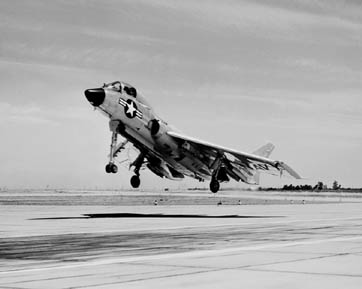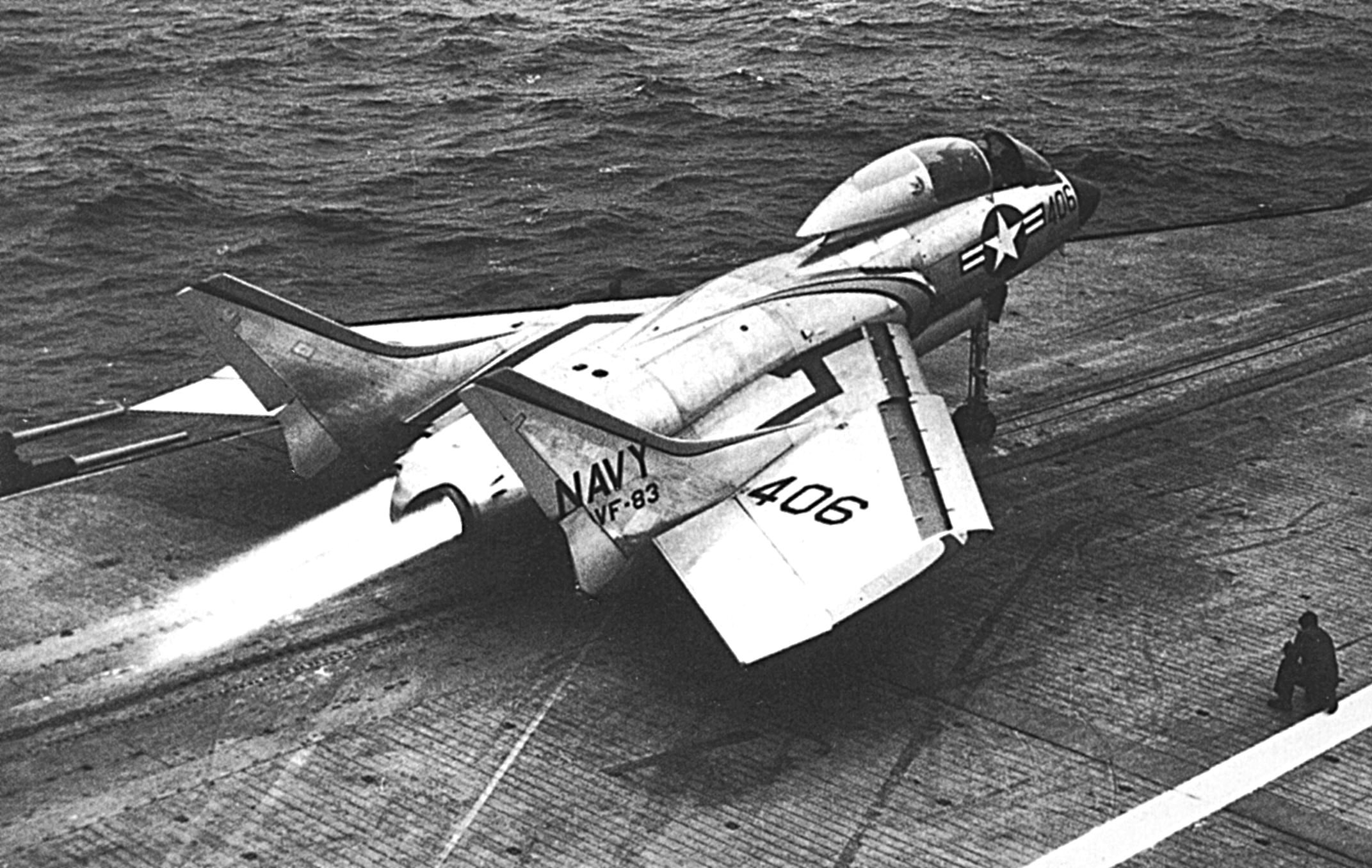The Vought F7U Cutlass, a name now synonymous with pioneering innovation and exceptional design, is a classic emblem of the rise of jet aviation in the mid-20th century.
As an artefact of post-war ambition and aeronautical advancement, the Cutlass broke away from traditional designs and ushered in a new era of naval aviation. Despite the hurdles and challenges it faced, the F7U Cutlass remains a fascinating case study for aviation enthusiasts and history buffs alike.
Contents
Development
The Cutlass emerged from a post-World War II period marked by rapid advances in technology and ambitious design philosophies.
Read More: Chuck Yeager – The Fastest Man Alive
The path to its development was indeed a tale of triumph over traditional norms, interwoven with challenges posed by groundbreaking technology.
The genesis of the F7U Cutlass can be traced back to a US Navy proposal in 1945, seeking a high-speed, carrier-based jet fighter.

Vought, a name already well-respected in the world of naval aviation, won the contract with their revolutionary design inspired by the aerodynamic theories of Dr. Alexander Lippisch.
This German engineer had proposed that a ‘tailless’ aircraft design could result in a more aerodynamically efficient and faster aircraft.
The initial concept of the Cutlass was indeed radical and futuristic. The F7U was to be a tailless plane, with a swept-wing design that aimed to minimize drag and thus maximize speed.
The design was a dramatic departure from conventional aircraft norms of that era.
The first prototype, the XF7U-1, was completed in late 1948 and was initially flown with two Westinghouse J34-WE-32 turbojets, as the intended Westinghouse J34-WE-42 engines were not yet available.

On its maiden flight in September 1948, Vought’s Chief Test Pilot, J. Robert Baker, flew the XF7U-1 for a mere 13 minutes, after which an undercarriage malfunction forced him to make an emergency landing.
Despite the setback, Vought continued the development, correcting errors, and introducing improvements in design and performance.
A total of 14 pre-production F7U-1 aircraft were built, serving primarily in testing and development roles.
Read More: Hawker Sea Fury – From Warbirds to Racers
Design
The F7U was truly a radical departure from the conventional aircraft design of its era. Featuring a unique, tailless design, this naval aircraft incorporated a variety of innovative elements that set it apart from its contemporaries.
One of the most striking elements of the design was its “tailless” configuration.
Taking inspiration from the work of German aerodynamicist Dr. Alexander Lippisch, Vought adopted a swept-wing approach that eliminated the traditional tail assembly seen in most aircraft of the period.
This design aimed to improve the aerodynamic efficiency of the aircraft and minimize drag at high speeds.
The Cutlass’s wing design was equally distinctive.

Often referred to as a ‘batwing’ or ‘inverted gull’ wing, it employed an 18-degree anhedral angle at the root, transitioning to a 7-degree dihedral at the wingtips.
The wings themselves were quite thick, housing the main landing gear and providing space for fuel storage and the carriage of weapons.
The F7U was powered by two Westinghouse J46-WE-8B turbojet engines, each capable of producing up to 6,100 lbs of thrust with afterburner.
The choice of engine was crucial to the Cutlass’s high-speed performance and its ability to operate from aircraft carriers. However, the J46 engines became a contentious issue due to their reliability problems.
The cockpit of the F7U Cutlass was positioned quite far forward in the fuselage, providing the pilot with excellent forward visibility – a key requirement for carrier operations.
The Cutlass was also among the first aircraft to incorporate an ejection seat, a critical safety feature.
Inside, the cockpit was quite advanced for its time, featuring a radar scope, a gunsight with a lead-computing function (essential for aiming in air-to-air combat), and a variety of instrumentation necessary for navigation and flight control.

The F7U Cutlass was designed with a focus on air-to-air combat.
The primary armament of the F7U-3 variant consisted of four 20mm Colt Mk 12 cannons. In addition to the cannons, the Cutlass could carry a variety of external loads on its underwing hardpoints, including bombs, rockets, and in the case of the F7U-3M variant, AIM-7 Sparrow air-to-air missiles.
The landing gear of the Cutlass was designed with the rigorous requirements of carrier operations in mind.
Read More: Westland Sea King – Guardian of the Seas
It featured a dual-wheel nose gear and single-wheel main gear units housed in the wing roots, a setup designed to handle the heavy loads imposed by carrier landings.
The design of the Vought F7U Cutlass, while ambitious, was also fraught with challenges.
Its radical design, while conceptually promising, led to numerous difficulties in practice, from unstable flight characteristics to persistent mechanical problems.
Nonetheless, the Cutlass’s design represents a bold attempt to push the boundaries of aviation technology during a period of rapid development and innovation.

Variants
The F7U-1 was the initial production variant of the Cutlass. First flown in 1948, the F7U-1 was a unique and daring design featuring a tailless swept-wing configuration.
Powered by a pair of Westinghouse J34-WE-42 turbojets, the F7U-1 was indeed an experimental prototype that paved the way for future developments.
14 F7U-1s were produced, primarily serving in testing and development roles.
The F7U-2 was planned as an upgraded version of the F7U-1, equipped with more powerful Westinghouse J34-WE-42 turbojets. However, the development was hampered by ongoing issues with the engines’ reliability and performance. Eventually, this variant was cancelled before any aircraft were built.
The F7U-3, the most produced Cutlass variant, represented a substantial leap in terms of performance and capabilities. Equipped with two Westinghouse J46-WE-8B turbojets, the F7U-3 was larger and heavier than the -1, with a more refined design.

The F7U-3M variant heralded the arrival of guided missile armament in the Cutlass series.
This version of the Cutlass was adapted to carry the AIM-7 Sparrow air-to-air missile, marking the first time this technology was incorporated into a U.S. Navy aircraft.
The introduction of missile technology dramatically enhanced the aircraft’s air-to-air combat capabilities, marking a significant milestone in the evolution of naval air power.
The F7U-3P was a reconnaissance version of the Cutlass, fitted with photo cameras and additional avionics for its mission profile.
Despite being unarmed, this variant provided valuable information-gathering capabilities, further adding to the versatility of the Cutlass design.

The final production model of the Cutlass series, the F7U-4, came with improved engines and several minor modifications to enhance flight performance and safety. However, it retained the familiar design and general characteristics of the F7U-3.
The progression of the Cutlass, from its first iteration to its final version, underscores the constant evolution and refinement intrinsic to aircraft design and development.
Each variant of the Cutlass added new dimensions to its capabilities in a testament to the drive for progress in the field of aviation.
Despite its turbulent operational history, the Vought F7U Cutlass and its various iterations have left an indelible mark on the history of naval aviation.
Operational History
Following its first flight in 1948, the F7U-1 went through a series of tests and trials before entering operational service with the United States Navy in 1954.
The aircraft’s unique design and its ability to reach high speeds made it an enticing prospect for the Navy, which was eager to upgrade its carrier-based fighter fleet with jet-powered aircraft.

The first squadron to receive the Cutlass was VF-81, which deployed aboard USS Saipan in 1954. Other squadrons that flew the Cutlass included VF-124, VF-81, VF-83, and VF-154, among others.
Over its operational history, the Cutlass saw service on various aircraft carriers, including the USS Hancock, USS Midway, and USS Coral Sea.
In terms of missions, the Cutlass was primarily intended for air-to-air combat, though it also had some capacity for ground attack with its ability to carry rockets and bombs. Its potential for high speed and its advanced (for the time) radar and fire-control systems made it a formidable opponent in air-to-air engagements.
However, the operational life of the F7U was fraught with problems.
The aircraft’s unique design led to a host of handling issues. The Cutlass was difficult to control, especially at low speeds, making carrier operations particularly hazardous.
The poor reliability of the aircraft’s Westinghouse engines led to frequent mechanical failures, and the Cutlass soon gained an unenviable reputation among its pilots.
Furthermore, the F7U was involved in a large number of accidents. Out of the 320 aircraft produced, over a quarter were lost in accidents, and the type was responsible for the deaths of four squadron commanders, an unusually high number.

Because of these issues, the F7U was phased out of frontline service by the late 1950s, with the last operational Cutlasses being retired by 1959.
Its service life was relatively brief compared to other contemporary aircraft, reflecting the difficulties encountered in its operation.
Conclusion
The story of the Vought F7U Cutlass is a testament to both the ambition and the challenges of pioneering new technology. Despite its difficulties, the Cutlass was an aircraft ahead of its time, pushing the boundaries of design and technology.
Read More: The Boeing 307 – Pioneer of the Modern Airliner
Its legacy is not one of a flawless aircraft but as a symbol of a daring, adventurous time in aviation history.
The F7U Cutlass remains a notable chapter in the annals of naval aviation, inspiring future generations of aircraft designers to challenge conventions and to dream beyond the horizon.
If you like this article, then please follow us on Facebook and Instagram.
Specifications
- Crew: 1
- Length: 41 ft 3.5 in (12.586 m)
- Wingspan: 39 ft 8 in (12.1 m) * Span wings folded: 22.3 ft (6.80 m)
- Height: 14 ft 0 in (4.27 m)
- Empty weight: 18,210 lb (8,260 kg)
- Gross weight: 26,840 lb (12,174 kg)
- Max takeoff weight: 31,643 lb (14,353 kg)
- Powerplant: 2 × Westinghouse J46-WE-8B after-burning turbojet engines, 4,600 lbf (20 kN) thrust each dry, 6,000 lbf (27 kN) with afterburner
- Maximum speed: 606 kn (697 mph, 1,122 km/h) at sea level with Military power + afterburner
- Cruise speed: 490 kn (560 mph, 910 km/h) at 38,700 ft (11,800 m) to 42,700 ft (13,000 m)
- Combat range: 800 nmi (920 mi, 1,500 km)
- Service ceiling: 40,600 ft (12,375 m)
- Rate of climb: 14,420 ft/min (73.3 m/s) with Military power + afterburner







